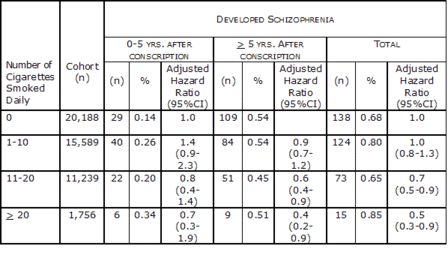ASHES, Vol. 1(3) – An unlikely protector: Understanding the link between smoking and schizophrenia
The prevalence of smoking among schizophrenics is higher than in the general population (Zammit, Allebeck, Dalman, Lundberg, Hemmingsson, & Lewis, 2003). It is unclear whether this association is an antecedent risk or an effect of the illness. This week, ASHES reports on a recent study by Zammit and his colleagues (2003) that investigated the relationship between smoking as a young adult and the risk for developing schizophrenia.
The authors examined records for 50,087 men who entered1 the Swedish army during 1969-1970 and were 18 through 20 years old upon entry. Upon enrollment into the army, men were asked to take a personality test and an IQ test; they also were expected to complete questionnaires about their family, social background, substance use and behavior during adolescence. Zammit et al. (2003) tracked this sample from 1970 to 1996 in the Swedish National Register of Inpatient Care (SNRIC).2 If admitted to a hospital, patients completed the Nordic version of the ICD-83. The authors adjusted the analyses to control for factors commonly associated with schizophrenia to determine the risk independently attributable to smoking. In the initial and unadjusted analysis, there was no relationship between smoking and schizophrenia. However, after adjusting for schizophrenia-related factors such as social integration, disturbed behavior, IQ, and family economy, cigarette smoking at ages 18-20 was associated with a lower risk for schizophrenia among medium and heavy smokers.

Figure. Smoking rates at ages 18-20 and risk for the development of schizophrenia (adapted from Zammit et al., 2003). Click image to enlarge.
Note. n = number of participants; CI = confidence interval. For a definition of hazard ratio and adjusted hazard ratio, click here.
Table 1 shows that individuals who smoked cigarettes at least moderately, 11 or more cigarettes per day, at ages 1820 were at reduced risk for developing schizophrenia during the quarter-century follow-up period. Most (72%) of the subjects were diagnosed as schizophrenic more than 5 years after conscription. The Figure also shows that smoking at conscription did not reduce risk for schizophrenia during the first five years post conscription. Interestingly, more of the smokers who would be diagnosed as schizophrenic (n = 212) were diagnosed during the first five years (32%) post recruitment compared to non-smokers for whom only 29 of 138 (21%) were diagnosed in the first five years. Subjects were not assigned to smoking or non-smoking groups; they decided whether or not to smoke on their own. Therefore we cannot determine whether smoking is a protective behavior or whether smoking is an expression of other unmeasured factors that reduce the likelihood of developing schizophrenia. Furthermore, Zammit et al. (2003) conducted follow-up via hospitalization records; hence individuals who developed schizophrenia and never entered a hospital would not be included.4 Finally, the study only examined men: more research is necessary to determine whether the reported risk rates hold for women.
Nevertheless, this research raises interesting questions about the multiple roles of nicotine and the etiology of schizophrenia. Nicotine has been determined to act as an inhibitor for the development of schizophrenia in moderate (11-20 cigarettes/day) and heavy (> 20 cigarettes/day) smokers. However, it is important to note that schizophrenia affects a small group of the population, whereas smoking cigarettes is much more common. For that statistical reason, the overall impact of gaining protection by smoking is negligible; it is likely that the population based risks outweigh the benefits.
–Siri Odegaard.
Notes
1. The government only excused 2-3% of the male population from enlistment.
2. The SNRIC tracks all hospital admission in Sweden. The authors report that the database tracked 70% of admissions in 1970, 83% in 1973, and 97% from 1974 onward.
3. International Classification of Diseases, Revision 8 (1965).
4. The authors note the about 90% of individuals who develop schizophrenia enter a hospital at some point during their lifetime.
References
Zammit, S., Allebeck, P., Dalman, C., Lundberg, I., Hemmingsson, T., & Lewis, G. (2003). Investigating the association between cigarette smoking and schizophrenia in a cohort study. American Journal of Psychiatry, 160(12), 2216-2221.
What do you think? Please use the comment link below to provide feedback on this article.